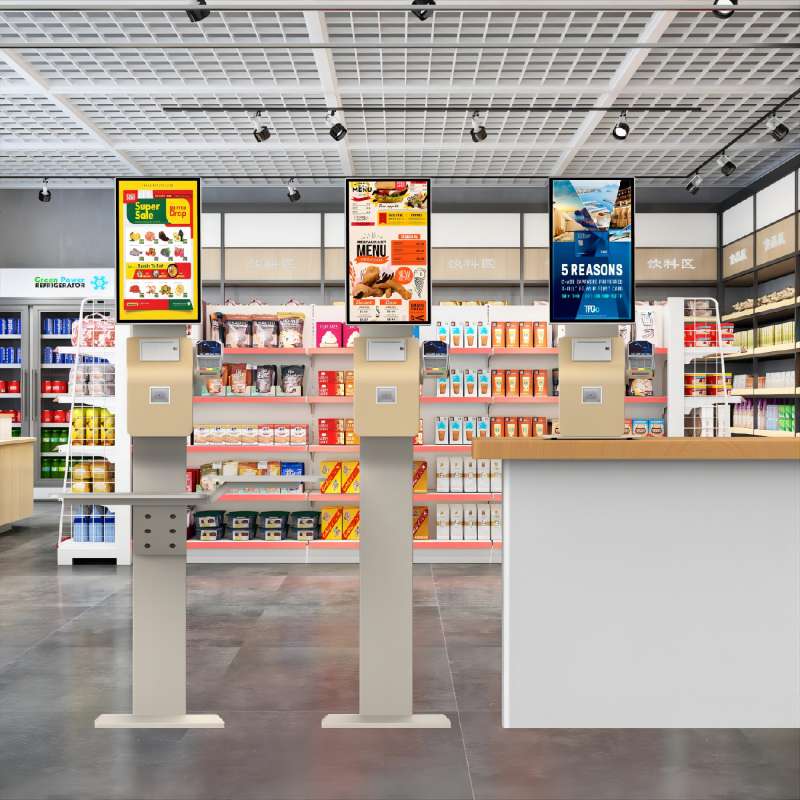Product Details
| Place of Origin: | kiosk manufacturer |
|---|---|
| Brand Name: | Lien |
| Certification: | FCC, CE, ROHS |
| Model Number: | LKS-8379 |
Payment & Shipping Terms
| Min Order: | 10 UNITS |
|---|---|
| Price: | $ |
| Packaging: | Strong Case |
| Delivery Time: | 5-6 weeks |
| Payment Terms: | TT |
| Supply Ability: | 5000 units per month |
Detailed Product Description
Kiosk Touch Monitor Retail Supermarket Vertical Self-service ordering cash registers combines touchscreen technology, self-checkout systems and cash management features designed to enhance the customer shopping experience while improving cashiering efficiency and reducing labour costs.

Components | Details | |
PC system | Industrial Board | Seavo/ Gigabyte/Advantech AIMB 562 |
CPU | Dual core E5700/G2020, 2.8ghz; Intel Dual Core I3/I5/I7 | |
RAM | 2GB /4 GB / 8GB | |
HDD | 500G | |
Interface | 6 RS-232 Ports;1 LTP;6 USB Ports,1 10/100M Net Port ;Integrated Net Card, Sound Card | |
PC Power Supply | HUNTKEY/Great Wall | |
LCD monitor | Screen Size | 17 inch/19inch ( optional from 8inch to 65inch) |
Brightness | 250cd/m2 | |
angle | horizontal 100°above;Vertical 80°above | |
Contrast | 1000:1 | |
Backlight tube life | more than 40,000hours | |
Max. resolution | 1280×1024 | |
Touch screen | Screen Size | 17/19 inch Diagonal ( optional from 8inch to 65inch) |
Resolution | 4096x4096 | |
High Transparence, high precision and durability,Orientation precision< 2mm(0.080 inch);pure tempered glass;Single-point touch Life expectancy more 50,000,000 times | ||
vertical touchscreen
The vertically mounted touch screen is easy for customers to stand and operate without having to bend over or look for a specific angle. The high-definition display provides an intuitive, clear shopping interface and supports touch operation to enhance the user experience.
self-service
Customers can select products, check price, add to shopping cart and complete payment independently through the touch screen. Support a variety of payment methods to meet the payment needs of different customers. Part of the equipment has a scanning code payment function, the customer only need to scan the bar code or two-dimensional code to complete the purchase.
Efficient cashiering
Built-in efficient cashiering system that can automatically process orders, calculate total price, print small tickets and other processes. Supports quick checkout, reducing customer waiting time and improving cashiering efficiency. Connected with the supermarket inventory management system, real-time update of inventory information to ensure sufficient supply of goods.
Intelligent Management
Equipped with intelligent recognition technology (e.g. face recognition, product recognition, etc.) to improve security and accuracy. Supports data analysis function, collects data on customers' shopping behaviour, and provides supermarkets with market analysis and decision-making support. Customisable interface and operation process to meet the individual needs of different supermarkets.
Widely used in large supermarkets, convenience stores, fresh food supermarkets and other retail places, especially suitable for easing cashier queues during peak periods.

By providing customers with the option to use self-service terminals, supermarkets can significantly reduce the wait time at traditional checkout counters. This is especially beneficial during peak hours, when long queues can deter potential shoppers or lead to frustration among existing customers. With self-service, customers can quickly scan and pay for their items, minimizing their wait and maximizing their shopping experience.
Self-service terminals offer a level of convenience that traditional checkout lines cannot match. Customers can scan items at their own pace, review their purchases, and make changes if necessary before finalizing the transaction. This autonomy empowers customers and gives them a sense of control over their shopping experience.
With self-service terminals handling a significant portion of checkout transactions, supermarkets can reduce the number of cashier staff required. This not only leads to direct savings in wages and benefits but also reduces the need for additional training and scheduling.
The freed-up staff can be redeployed to other areas of the supermarket where their skills and expertise are more valuable, such as customer service, stock replenishment, or assisting with online order pickups. This flexibility allows supermarkets to better manage their workforce and ensure that resources are allocated efficiently.